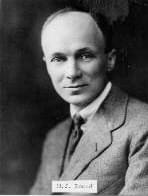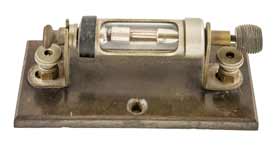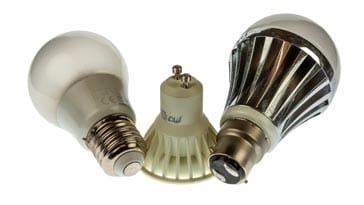LED History: the invention of the light emitting diode
The Light Emitting Diode, LED is well established in the electronics industry today . . but the invention of the LED and its history seemed fated as many attempts were unsuccessfully made to bring it to the world.
History of Semiconductor Diodes Includes:
PN junction diode invention
LED history
Zener diode invention
More semiconductor history
History of semiconductor technology development
Transistor history
Invention of the integrated circuit
The history of the invention of the LED, light emitting diode dates back to some of the earliest days of wireless technology - a time when little was understood about semiconductors themselves and even less about the possibility of using them to generate light.
LEDs have been commercially available since the 1960s, but the LED history extends many years before this - the LED invention has its roots in much earlier developments.

The LED took many years to develop for a number of reasons - the first discoveries were well ahead of their time, other discoveries were lost as a result of war. It was only when the allied technologies were sufficiently mature that the LED could be fully developed and marketed.
Even after the first of these electronic components appeared, LED history was not finished - new developments and inventions have been made and LEDs are addressing new markets, never really envisaged before. These electronic components are now used more widely than ever before as a result of new innovations.
Note on Light Emitting Diode Technology:
Light emitting diodes are widely used in many areas of technology. There are many types of LED, but the traditional inorganic types used compound semiconductors to emit light. Today many different colours are available and the technology has enabled them to be used for everything from panal indicators to displays and backlights to domostic and automotive lighting.
Read more about Light emitting diode, LED technology
Video: Surprising facts about the LED discovery & history
Early LED history
The first recorded effects of the light emitting diode effect were noticed back at the beginning of the twentieth century. A British radio engineer named H J Round who worked for Marconi and undertook some experiments using crystal detectors.
At the time radio detectors were one of the major limiting factors within the early wireless of radio sets. He was a very talented engineer and helped advance the science of radio in many ways.

Image courtesy Marconi plc
The early detectors were often made using crystals of what we would call semiconductors. A thin wire was placed onto the surface and a point contact diode was made. These were called "Cat's Whiskers" for obvious reasons.

In trying to investigate the effects and improve their performance, Round had passed a current through some of his detectors. He noted that one of them emitted light when a current was passed through it. Although he did not understand the mechanism for the effect, he published his findings in 1907 in a magazine of the day named Electrical World.
To the Editors of Electrical World:
Sirs:- During an investigation of the unsymmetrical passage of current through a contact of carborundum and other substances a curious phenomenon was noted. On applying a potential of 10 volts between two points on a crystal of carborundum, the crystal gave out a yellowish light. Only one or two specimens could be found which gave a bright glow on such a low voltage, but with 11 volts a large number could be found to glow. In some crystals only the edges gave the light and others gave instead a yellow light, green orange or blue. In all cases tested the glow appears to come from the negative pole, a bright blue-green spark appearing at the positive pole. In a single crystal, if contact is made near the center with the negative pole, and the positive pole is put in contact at any other place, only one section of the crystal will glow and that the same section wherever the positive pole is placed.There seems to be some connection between the above effect and the e.m.f. produced by a junction of carborundum and another conductor when heated by a direct or alternating current; but the connection may be only secondary as an obvious explanation of the e.m.f. effect is the thermoelectric one. The writer would be glad of references to any published account of an investigation of this or any allied phenomena.
H. J. Round
LEDs investigated by Losov
The history of the LED shows the idea remained dormant for many years - its invention and use was still a number of years away.
Then it was observed again by a Russian engineer named Oleg Vladimirovich Losov. He was the son of a Russian Imperial Army Office - born into a noble family. This would have counted against him in the post revolution Russia era.
Losov has attended a number of university lectures but never undertook any formal university education, but instead was a technical at the Leningrad Medical Institute.
Losov made some major advances and is a key person in the invention of the LED and its history. He undertook a considerable amount of work investigating light emission from Cat's Whisker style detectors. He observed and investigated the light emission from zinc oxide and silicon carbide crystal rectifiers.
As a result of his observations and investigations, Losov published a number of papers in the technical press of the day between 1924 and 1930. His first paper was entitled: "Luminous carborundum detector and detection crystals" which was published in a Russian journal.
Soon he published his findings in other British and German. Losov detailed a variety of aspects of these diodes including the spectra of their light emission as well as many other aspects of their operation.
In one article published in the Philosophical Magazine in 1928 he detailed the I-V characteristics of a carborundum diode along with the onset of light emission. This formed part of his work on investigating the nature of the diode emission - recognising it was not a thermal effect, but arising from the semiconductor action.
In further work, Losov investigated the temperature relationships of the effect, cooling the semiconductors down to very low temperatures. He also modulated the LED to see the effects of frequency of any current applied to the diode.
Losov went on to investigate further ideas associated with diode and what would later be called semiconductor technology.
Sadly though, he lived in Leningrad and he was killed during the siege of Leningrad during the Second World War.
He had published a total of four patents between 1927 and 1942, but all this work was lost as records were destroyed in Leningrad.
LED history: the invention approaches
During the Second World War, radar was seen as a major enabler. Accordingly a large amount of development of practical devices for radar was initiated. This utilised much of the materials science work that had been undertaken in the 1920s and 1930s.
As a result of the work new point contact diodes were invented and developed. These were able to provide better performance than thermionic valve / vacuum tube diodes.
As a result of the research into semiconductor diodes, the idea for the light emitting diode re-surfaced in 1951. This time work was to be more successful, although it took some years to reach completion.
One research team was lead by Kurt Lehovec. He applied for a patent in 1952 for Silicon carbide diodes that emitted light. However this was only the first phase of the work that was needed for the invention of the LED.
Following the work by Kurt Lehovec, others also started to work on LED technology. The work took many years and involved a number of companies and researchers. Even Shockley became involved. The work on the invention of the LED took many people and was spread over many years.
Although LEDs did not become commercially available for a number of years, several people made some significant discoveries and improvements.
Lehovac himself investigated introducing different impurities to change the colour of the light making blue, green/yellow, and pale yellow from different combinations.
Also researchers working at RCA patented a green LED in 1958. All of these LED developments added more to LED technology, furthering the technology within the overall LED history.
Commercial LED history
The first commercially available LEDs started to appear in the mid 1960s. These early versions of these electronic components used a semiconductor made using gallium, arsenic and phosphorus - GaAsP. This produced a red light, and although the efficiency of the devices was low (typically around 1 - 10 mcd at 20mA) they started to be widely used as indicators on equipment.
1962 was a busy year for LED development with a number of companies reporting infra-red devices. In August 1962, Biard and Pittman filed a patent titled "Semiconductor Radiant Diode" for a zinc-diffused PN junction LED with a spaced cathode contact which generated infrared light under forward bias. This was probably the first LED, albeit only providing infra-red emission.
However the quest was still on to produce LEDs that gave visible light. This was achieved by J. W. Allen and R. J. Cherry in late 1961 working at the SERL in Baldock, UK. This work was reported in the Journal of Physics and Chemistry of Solids
Another major step forwards was taken by Nick Holonyak, Jr. who in 1962 invented an LED that could produce visible red light and this was while he was with General Electric.
However, one of the first companies to manufacture LEDs on any scale was Monsanto. Monsanto was actually a company supplying the raw semiconductor materials. They had aimed at working with Hewlett Packard - then a test equipment company. The arrangement was to be that Monsanto wojld supply the semiconductor material and Hewlett Packard would undertake manufacturing the diodes.
Unfortunately the relationship did not work out and Monsanto ended up developing and manufacturing the LEDs themselves. [The name of Monsanto is not seen today. The business was sold in 1979 to General Instrument.]
With the original GaAsP devices being manufactured, the next development saw gallium phosphide devices developed. GaP devices were not widely used because the light they produced was at the far end of the red spectrum where the sensitivity of the human eye is low, and even though they produced a high output, the human perception was of a dim light.

After the first developments a number of other major milestones took place:
- 1964: IBM started to use LEDs on computer boards - this was probably the first time printed circuit board assemblies had LEDs incorporated into them.
- 1968: Hewlett Packard launched its calculators and started to use LED indicators for their displays - this was one of the first major uses for LED displays.
- 1971: The production of coloured LEDs apart from red had been an issue and Edward Miller and Jacques Pankove developed a blue LED.
- 1993: Physicists Isamu Akaski and Hiroshi Amano developed high-quality Gallium Nitride for use in fabricating blue LEDS, again moving forward the standard and manufacturing processes for non-red LEDs.
High output LED lamps
One of the next stages in the LED history was the development of high brightness LEDs. As LEDs were developed, the light levels increased to the extent that they could be considered for applications outside simple indicator lamps.
By 1987 the Hewlett Packard AlGaAs (aluminium gallium arsenide) diodes being produced were bright enough for use as electronic components within lighting applications.
Initially these diodes were used within the automotive industry where red LEDs were ideal for vehicle brake lights, and also for traffic lights. Here the use of LEDs was of particular interest because of their increased reliability over the incandescent lights that had been previously used.
A year after the first AlGaAs LEDs were introduced another variant, AlInGaP (aluminium Indium Gallium Phosphide) were manufactured. These LEDs gave a significant improvement over the previous AlGaAs diodes by doubling the light output.
Later, in 1993 HP started to use GaP (gallium phosphide) to provide high output green LEDs. Also further developments of these electronic components allowed the production of high output orange lamps. These were ideal for use as car direction indicators - again their reliability in being turned on and off as well as their efficiency proved to be a major improvement.

A huge amount of development was invested in developing LEDs for lighting. Around 2002 White LEDs for residential use started become commercially available although the cost was outside the reach of many as they cost around $100 per bulb.
Nevertheless costs soon started to fall and their use overtook that of both incandescent and the energy saving Compact Fluorescent Lamps, CFLs as the lighting bulb of choice.
LED history continues
With the increasing use of LEDs as a result of their high efficiency and many other advantages, the history of the LED did not finish - more LED inventions were to come. In fact it is still very much an on going story.
New developments and inventions are being made and LED technology is continuing to move into new areas with the development of organic LEDs and for their use with lighting.
LEDs are now a well established form of electronic component used in many electronic circuit designs - they are used as small indicators as well as for lighting, both domestic and industrial. Their use will only increase as time progresses.
 Written by Ian Poole .
Written by Ian Poole .
Experienced electronics engineer and author.
More History:
Radio history timeline
History of the radio
Ham radio history
Coherer
Crystal radio
Magnetic detector
Spark transmitter
Morse telegraph
Valve / tube history
PN junction diode invention
Transistor
Integrated circuit
Quartz crystals
Classic radios
Mobile telecoms history
Vintage mobile phones
Return to History menu . . .



